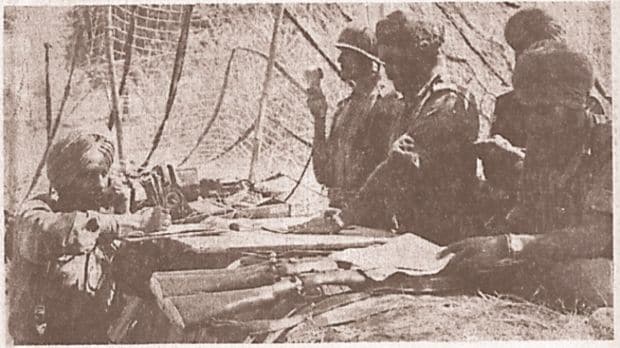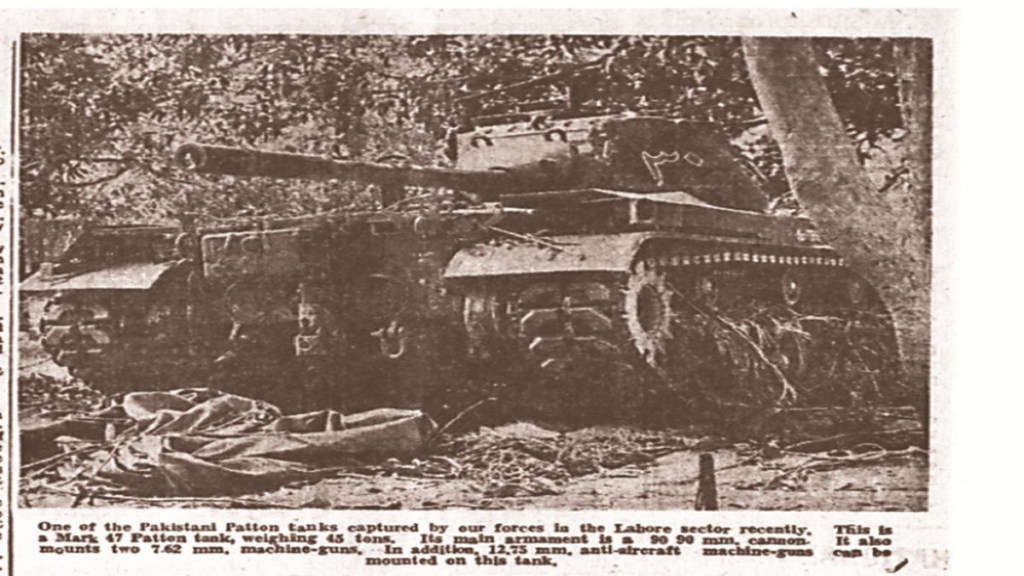By Raju Mansukhani
“The lesson is clear. Sophistication in weapons and a preponderance of fire support do not by themselves provide an answer to a successful attack.” The war with Pakistan confirmed the adage that in the final test of battle it is the man behind the gun that matters, wrote Lt Gen Harbakhsh SinghVrC in the ‘War Despatches’ which take us deep into the battlefields and theatres of war during the Indo-Pak conflict of 1965.
As General Officer Commander-in-Chief Western Command, Lt Gen Harbakhsh Singh shared innumerable lessons learnt before and during the war. He admitted that the Pak infantry was equipped with a range of sophisticated weapons which was the envy of any Eastern Army. Yet, the range of foreign equipment was not enough for Pakistan to clinch the pitched battles being fought along the borders of Punjab and Jammu & Kashmir.
“Pakistan’s actions were supported by tank and artillery fire on a scale comparable to the extravagance practiced in the American Army. And yet, in most cases, where our troops stood their ground, Pak infantry failed to make any impact for it fought shy of closing in physically with the defender. The lesson is clear. Sophistication in weapons and a preponderance of fire support do not by themselves provide an answer to a successful attack; the infantry must come to grips with the defender and evict him by physical force, if necessary,” he wrote.
In war, the will power of Generals and Jawans alike is as important as weaponry, summed up Lt Gen Harbakhsh Singh VrC in his inimitable style.
The battle-scarred General, who had seen military action across the Asian theatres of war since the 1940s, was certainly not enamoured of ultra-modern equipment. Hi-technology equipment, he felt, was not an asset unless it is matched by the genius of its user. He gave the example of the Patton tanks which Pakistan possessed.
“The Patton was the last word in armour at the stage in both our Armies, but it’s complicated gadgetry was beyond the understanding of the average Pakistani. In this case, the man behind the gun was literally found wanting,” he shared.
In the pitched battles along the Punjab border, he recounted the delayed action of the Patton tank crews who were busy feeding information into the tank’s computer. And so involved in ensuring a perfect shot that the tank rarely got the chance to fire! Compared to this America-gifted armour, the Indian Army was equipped with the rough and ready gunnery. Older, simpler and less complicated armour was instrumental in knocking the Patton tanks off, time and again.
“This excellent tank met its Waterloo in the fields of Phillora and Asal Uttar. This may sound like a paradox but the sheer modernity of the Patton was its undoing,” commented the General, providing yet another lesson worth remembering till date.
He goes a step further in analysing why Pakistan’s dependence on foreign military equipment was problematic. There is no doubt that Pakistan made lavish use of its artillery and armour in the opening stages of the war; its objective was to ‘shock and awe’ the Indian Armed Forces. Alternatively, Pakistan was aware that the early intervention of the United Nations could put an end to the war. He attributed this show of flashy armour and heavy firing to a rather unimaginative adoption of the American doctrine of massive use of fire power to conserve manpower.
“Whatever the reasons, I consider it an unwise policy to indulge in an extravagance which has no foundation in indigenous production. The availability of foreign supplies during war should be treated only as a bonus – a complete reliance on it is tantamount to courting disaster,” said the General.
Subaltern Contributions
In ‘War Despatches’, the compassion and humane qualities of Lt Gen Harbakhsh Singh VrC are evident for the reader today. It is especially touching when the General pays his homage, tributes to the magnificent role played by civilians in the September 1965 conflict.

He had witnessed the emotional backing provided by the country as a whole, and the Punjab, which he considered was most inspiring. Everyone was anxious to contribute his or her mite in whatever form possible. The demands of the time created a rejuvenation which completely changed the tone and tenor of society, he wrote.
The Punjabi citizenry’s contribution to the war front went far beyond the call of duty; these scenes off the battlefield are high on the emotional quotient. The General has recorded that the Punjabi had no mental reservations in the offerings he made to the cause of fighting off the invaders.
“His truck and tractors, his blood and sweat, the sacrifice of his crops, and the best in his household, even to the point of self-denial. Free canteens and stalls mushroomed overnight all over Punjab. Puris, halwas, lassi and milk were served to troops at every crossroad. Packets of fruits, biscuits and cigarettes were thrown into military trucks without asking,” he recounted.
There are memorable scenes of camaraderie and brotherhood unfolding which he was observing on the road. “What gladdened me the most was that the people had not lost their sense of balance and that they held no rancour against Pakistan. I was once barricaded on the road by some young girls serving puris and halwa outside Amritsar, and I noticed that a bus full of Pakistani prisoners of war was being served with these delicacies in the same manner as our jawans – what better sign of a nation’s maturity.”
It could be the story of one civilian truck driver, and there were probably thousands of them who drove their vehicles day and night without rest or sleep, and sometimes even food, facing all the frontline hazards to keep the jawan supplied with the essential needs.
The General found it an unforgettable sight to see the farmer mow down his green crops, the only source of his livelihood, in a bid to track down the Pakistani paratroopers. And risking his life, the peasant often carried his household produce to feed the men in the forward line.
And as the jawan fought from the trench, the farmer continued to toil next door on the land. The farmer was indifferent to the enemy air action or the danger of a ground threat. It was a cheek by jowl relationship which developed between the two, which deepened into a sacred bond as the war progressed. The deeds of this selfless individual who gave his all without the expectations of reward or recognition.
Admiration & amusement
On 11 September 1965, the General was on the way to the battle scene of the previous day where a gruesome battle had been fought between the enemy’s 1 Armoured Division and the 2 (Independent) Armoured Brigade in the Khem Karan sector.
As a measure of security, he was dressed as an ordinary jawan without the paraphernalia of military rank. “An artillery vehicle hit by a bomb was burning furiously in a cotton field near the road and the shells were exploding in all directions with a deafening roar. A few yards away, within the immediate glow of the flames, and under the shadow of a thick spray of deadly splinters, was a party of Sikh farmers completely absorbed in hoeing their crops, indifferent to the dangers of the situations,” he recalled.
The General walked up to these farmers in order to warn them off the dangers to which they were exposed. While the rest of the group continued their chore unperturbed, one of them paused briefly and turning to him in the manner of an indulgent veteran trying to calm the apprehensions of a neophyte, said “Sardar Sahib, you appear to be a stranger in these parts – if such minor incidents are going to stop our work, we shall be idle all day long.”
“Taken momentarily aback with the rebuff, I continued to stare at the group with a mixture of amusement and admiration, it was an inspiring scene: a sight fit for the Gods,” wrote Lt Gen Harbakhsh Singh VrC, the Western Army Commander, whose fighting spirit, and war stories continue to inspire us.
The author is a researcher-writer specializing in history and heritage issues, and a former deputy curator of the PradhanmantriSangrahalaya.
Disclaimer: Views expressed are personal and do not reflect the official position or policy of Financial Express Online. Reproducing this content without permission is prohibited.

